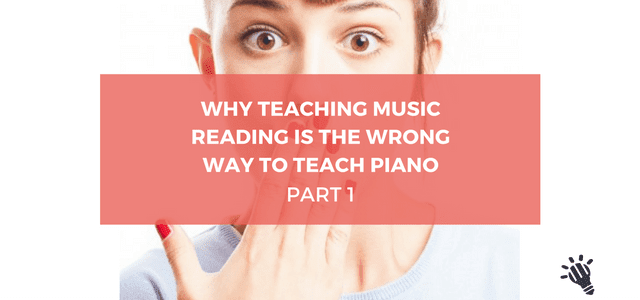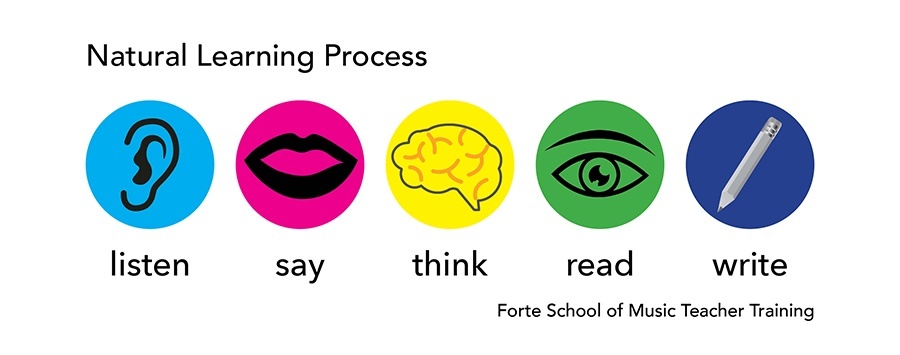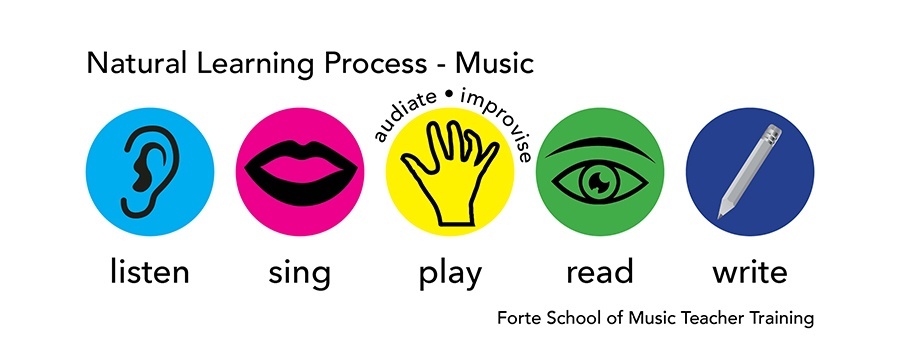
In this article, Inner Circle Expert teacher Paul Myatt will get you thinking about the order in which you are teaching music. What should come first: reading or listening/creating/singing?
As you might have guessed, there is a wealth of evidence to suggest that the best way to teach music is the same as the way we learn to speak language: listening first.
But how does that apply to piano teaching and what does it look like in practice? That’s exactly what Paul dives into in this article.
In fact, we’ve got so much to explore on this topic, that I’ve decided to break it into two articles. In Part 1, Paul uncovers the “Natural Learning Process” that should guide the way in which we teach music and we begin to explore multi-sensory learning.
I know you’re going to love this so let’s get started. – Tim Topham.
The battle-lines are surely drawn.
In the blue corner we have the readers and in the red, the by ear-ers. Of course we all know that to be a successful all-round musician (piano player), you need both….but how many of us teach both?
Regularly? Competently?
Join any Facebook group about teaching piano and you’ll regularly see a post devoted to ensuring children are reading and sometimes about children learning to play by ear, very occasionally about a child improvising or, shock horror, “making it up” (isn’t that called composing 😉 usually from a more progressive teacher, devoted to their craft.
In my experience, most teachers teach how they were taught, (funnily enough, the experts say the same thing).
Unfortunately in our profession, there are few opportunities to learn “how to” teach. Most tertiary courses offer limited pedagogy courses specifically designed for piano or instrumentalists. Add the lack of any regulation within the industry, creating low participation in professional development either musically or in business.
I imagine if you’re reading this, you probably are already engaged in your own professional development and that is a great thing, so keep reading!
Have you read the 2015 Keynote Address by Dr Edward E. Gordon at the National Conference on Keyboard Pedagogy held in the US?
Highly recommended reading.
Dr Gordon said,
“I am lead to believe piano is taught to many persons by teachers who typically teach the way they were taught, rather than according to an objective learning theory and current research”.
He goes on to say that he has no intention in being critical, however he wanted to share concepts that may encourage teachers to embrace new concepts in their own pedagogy.
Dr Gordon said using language as an analogy should make it easier to grasp what he explains about music instruction and in particular piano instruction.
He said, there are 5 language skill vocabularies: listening, speaking, thinking, reading and writing, each providing readiness for the next step.
Gordon emphasises that listening comes first and is fundamental, “Without a rich listening vocabulary, development of a speaking vocabulary with proper pronunciation is restricted.”

Gordon goes on to say,
“There are five parallel music skill vocabularies. In sequential order of development, they are 1) listening, 2) singing and chanting, 3) audiating and improvising, 4) reading, and 5) writing. As with language, listening is basic in piano instruction as well as all music instruction. Unfortunately, in typical instruction, listening is disregarded. Detrimental results are similar in music as in language when importance of listening is overlooked.”

Without incorporating listening and singing and/or chanting, the context of tonality is often lost.
How does one experience major and minor tonalities let alone modal tonalities without listening and/or singing? And then, what about meter? Should this not be experienced in the body? Gordon says, “It is indeed regrettable most students throughout the world display poor rhythm.”
So if you’re a good reader, you probably focus on this in your teaching.
If you enjoy playing by ear, you will generally teach your students to do that as well. Let’s face it, just like our students, we always like to do things that we’re good at!
Here’s the first challenge: encourage readers to play by ear, and play by ear-ers to read.
To start with I want to define teaching by ear and teaching by reading.
Let’s look at the options for learning music by reading.
Firstly one should look at the age of the student. If a child starts learning piano at the age for 5 or 6 years, then they are often too young read their own language fluently, therefore it is unlikely that they will be able to read the music, decipher it and then play it.
The variation in students’ ability to decode information from music in beginners, ages 7-11 years, is enormous.
An understanding of music notation and how it is deciphered and decoded by the brain, is important to start this conversation.
Music notation written on a stave is a vertical (up-down) representation of pitch and the piano is a horizontal (left-right) representation of pitch.
The next layer of complexity is the layout of notes on a piano.
Notes are not found by using the white keys, they are found by their relationship to the black notes. Keyboard geography is important to understand; and this explains why many courses begin with playing 2 or 3 black notes prior to playing white notes.
When a child does not have a strong background in two & three black note exploration, he or she will often mistake F for C and vice versa.

A student’s spatial awareness is essential for deciphering musical notation: turning the information around in one’s brain and then expressing that notation through the fingers playing notes on the piano.
In my dim dark past I have taught adults who were unable to decode music notation until I turned the music on its side, so that the printed score went in the same direction as the notes on the piano.
As piano teachers, we often don’t realise that our own basic assumptions around reading music are unfathomable for some people.
As playing music is a multi-sensory experience, ie we need to play, read & listen, I believe we, as piano teachers, we should teach using a multi-sensory approach.
Singing, clapping/moving and following the printed score along with a recording or the teacher playing will give students a multi-sensory experience of the music before actually playing.
Singing lyrics or note names (C, D, E or solfa/solfege) gives students an auditory experience. Clapping, moving or playing a percussion instrument gives students a kinaesthetic experience and following the notes on the printed music offers a visual experience of the music.
These multi-sensory experiences engage many different areas of the brain. Check out Anita Collin’s TEDx talk and Tim’s great podcast with Anita: What to say to parents when their child is about to quit.
I often relate multi-sensory learning and what happens in the brain to bush walking.
If you’re bush walking through virgin forests you’ve got to work hard to make tracks, where as, a well-worn track is easier to navigate.
Multi-sensory learning is like making well-worn pathways in the brain. Stronger conduits in the brain create improved memory (mechanical, auditory & analytical) and enhance learning.

Multi-sensory learning is much of the approach of the Orff-Schulwerk and Dalcroze philosophies.
Whilst neither is necessarily piano related, many of the strategies of the approaches can be related to, and incorporated into piano lessons.
Multi-sensory learning is also favoured for learning many subjects in school curriculums as well. See Tim’s Podcasts with Paula Melville-Clark and Vashti Summervill.
Incorporating multi-sensory learning into your lessons takes preparation and commitment to your own teaching pedagogy. There are many benefits to the students, generally they will:
In Part 2 of the series, I’ll let you know about some of the strategies that I use that can help make your teaching more multi-sensory.
We’ll discuss Aural Strategies, Reading Strategies and the Importance of Singing.
We’ll also cover some of the best resources for supporting your teaching including links to online resources, teaching frameworks and communities.
Do you start with reading? How do you help students listen and learn the fundamentals of rhythm?
How do you start your beginners? What does your first month of lessons look like?

Jane says:
I like your article – WHY TEACHING MUSIC READING IS THE WRONG WAY TO TEACH PIANO [PART 1] and agree with your approach.
I teach pre-service teachers at the University of Newcastle and use a similar pedagogy.
Jane Law
Vashti Summerviill says:
Paul! Thank you for this wonderful article. I wholeheartedly agree. This approach absolutely leads to more expressive and more creative playing. Off to read part 2. LOVE your work!
David says:
Hey Paul – great article. Thanks so much 🙂
Joanne Trewick says:
I enjoyed this article because I have long been against the pedagogical idea that if a student doesn’t have the skills to read the score for a piece then they shouldn’t be learning it.
I always focus on connecting students with music they enjoy and feel confident playing also teaching them to play musically, long before introducing a reliance on sight reading skills to learn new repertoire. For most students, transitioning to secure, reliable and independent decoding abilities naturally happens somewhere between 2 and 4 years of lessons. Note reading is not ignored, but it is not my primary focus. I also strongly advocate finding the individual way that each student’s brain connects with musical notation, rather than insisting that they learn to read in the way that makes most sense to me.
Paul Myatt says:
Hey Joanne – sounds like you’re doing a great job of teaching. Check out the 2nd part of this blog next week for some places to get some more training and professional development – cheers Paul Myatt (www.fortemusic.com)
Tanya Brooks, NCTM says:
Totally agree with this dude! I have had teacher training in Suzuki Piano and Violin years ago and this is what we were taught. Even though I also teach more traditionally depending on the student, these teaching concepts work the best to create a true musician in your studio. Plus it’s so fun to learn and make music this way. It’s a joy and not a chore!
Paul Myatt says:
Hiya Tanya – totally agree with you!
thanks,
“this dude” ;-p
Nachum says:
As a piano teacher, I have long came to similar conclusions. I liked the concept of “multi-sensory” . Among my adult learners have many of those with whom I have worked first without printed notes, but only with chord symbols. However, such an order requires further specific work on reading rhythm , for which I use the melodica – with excellent results. The melodica is more multi – sensory instrument than piano, it allows organically combine breathing, singing,, talking , notes pronunciation , rhythm, orientation on keyboard, the body movements (walking, even dancing) and sound production , allows to change parameters of sound – timbre, dynamics, vibrato, glissando. .
Paul Myatt says:
Thanks Nachum for your suggestions about melodica – it certainly adds to the sensory exploration of music.
cheers
Paul Myatt (www.fortemusic.com)